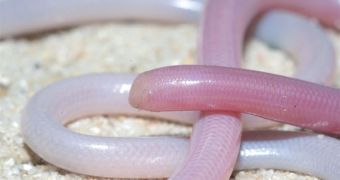Evolutionary biologists have always been curious as to how blind snakes, powerless and small creatures, managed to spread around the globe. It's not like they could travel at high speeds over large swaths of land, using only their bodies to make their way through the ground. Given this, many have been puzzled as to how the animals managed to make their way on all continents. The answer came from a recent genetic analysis, which showed that the blind snakes developed about 150 million years ago. It then became apparent to researchers how they got around, LiveScience reports.
A team of researchers from the Pennsylvania State University (Penn State), led by biology professor Blair Hedges, proposes that the creatures drifted on tectonic plates, as the continents broke apart millions of years ago. When they appeared, the supercontinent Gondwana was only breaking apart. This saw the island of Madagascar, currently located on the eastern side of Africa, breaking off from India. South America was already broken off from Africa, and Australia separated even further about the same time.
“Blind snakes are not very pretty, are rarely noticed, and are often mistaken for earthworms. Nonetheless, they tell a very interesting evolutionary story,” explains Hedges. He adds that the main difference between these creatures and earthworms is that the former have a spinal cord, whereas the latter don't. Additionally, the blind snakes can sense chemicals through their skin, which is how they get around the tunnels they dig underground. “We've identified living organisms – these blind snakes – that trace back to an ancient continent that split apart and then carried these snakes with them,” the expert further explains.
The creatures feast mostly on ant and termite larvae and eggs, and they consume impressive amounts of these things, given their size. “These blind snakes eat very small things, and they eat a lot of them. They'll go into a termite mound and just gobble up dozens and dozens of eggs and larvae,” Hedges says, adding that the mouth of the creatures acts like a conveyor belt at a grocery store. The animals are spread all over the world, although they can be found in larger proportions in the Southern Hemisphere and on tropical islands. More than 260 species have been identified thus far.

 14 DAY TRIAL //
14 DAY TRIAL //